As agriculture withers amid an ever-warming climate, a flexible approach to water management can help cushion the blow.
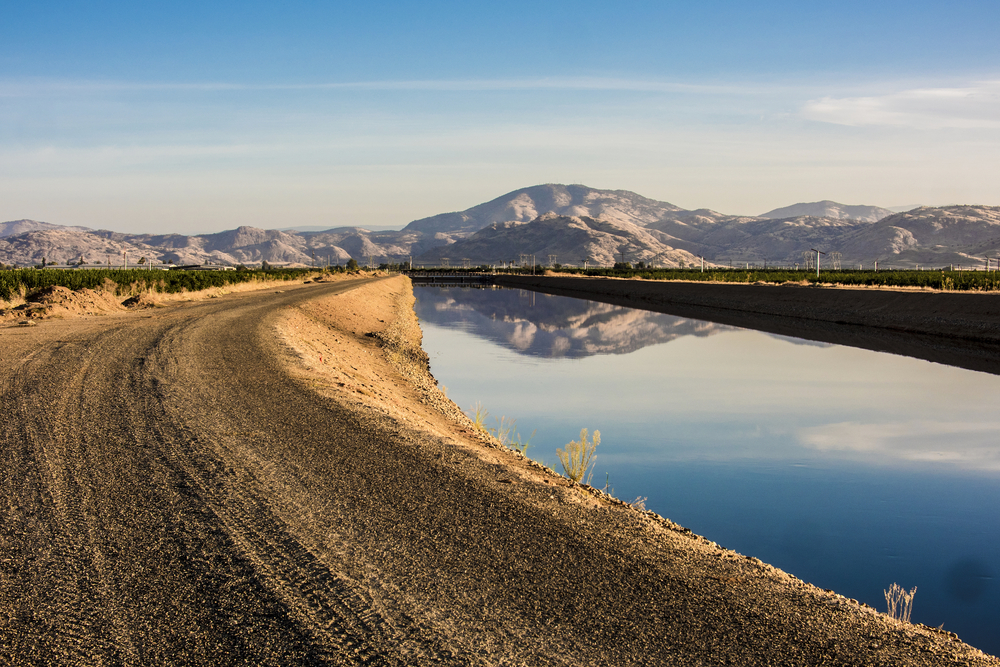
On a recent market day at the San Francisco Ferry Building, Tory and Rebecca Torosian of Tory Farms, a second-generation, 80-acre orchard in the San Joaquin Valley, are hawking the last of their navel oranges, lemons and pomegranates as they head into a long hiatus.
Normally, a late winter crop of oro blancos, page mandarins and other citrus carries them into spring, until their nectarines come into season. But for the past two years, the prolonged drought has left their ranch parched; along with slashes to water allocation, the region’s overdrawn water basin has left their wells sputtering.
“We had to prioritize the money makers—our stone fruit and grape vines—and let the other ones dry up,” says Tory. To date, he’s fallowed more than a third of his orchard, much of which the couple planted more than two decades ago. Although the outlook is brighter this year thanks to a historic bout of rain and snow, “replanting those varieties and getting them back to where they were would take five to seven years,” adds Rebecca, “and lots of money and water.”
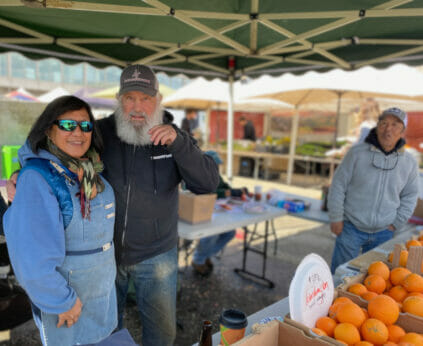
Tory and Rebecca Torosian of Tory Farms. (Photo by Naoki Nitta)
Most indicators point to a drier future for California, leaving even less water for irrigation. A recent study by the non-profit Public Policy Institute of California (PPIC) shows that by 2040, annual supplies could decline by as much as 20 percent. Yet the research notes that changing climate conditions are only part of the overall calculus. The bigger supply impact comes from the Sustainable Groundwater Management Act (SGMA), a state mandate to limit groundwater pumping to replenish chronically overtapped reserves.
Coupled with dwindling surface supplies and increased environmental regulations, California’s transition to groundwater sustainability could have particularly sobering consequences for the San Joaquin Valley, which is home to nearly 4.5 million irrigated acres and produces $35 billion in agricultural output. Future water constraints could, in the worst case, fallow as much as 900,000 acres of farmland, evaporating close to 50,000 jobs and shaving regional economic activity by 2.3 percent.
Still, a flexible approach to managing supplies can help the region squeeze the most out of a limited supply—all the while working to stabilize the economy and achieve groundwater sustainability.
“Inflexible water management is a costly way to cope with growing water scarcity,” says Alvar Escriva-Bou, a lead researcher on the PPIC study. So local, regional and state cooperation, together with innovative approaches to groundwater recharge and storage, “can really smooth down the impacts.”
An agricultural triage
Enacted in 2014, the SGMA sets a localized framework for managing groundwater extraction, with the long-term goal of restoring depleted basins. In its initial 2019 assessment, the PPIC predicted that the impact on the valley’s water supply could fallow up to 500,000 acres of farmland. “Back then, we didn’t have the data we have today,” says Escriva-Bou, who co-authored the original report, explaining the near-twofold increase reflected in the recent update. “We were looking at big numbers at the basin scale, and we didn’t know where the overdraft was happening.”
Since then, the establishment of Groundwater Sustainability Agencies (GSA)—public entities empowered with managing groundwater within a district—has revealed a more precise tally of local conditions, including “white areas” isolated from surface water deliveries and reliant solely on wells.
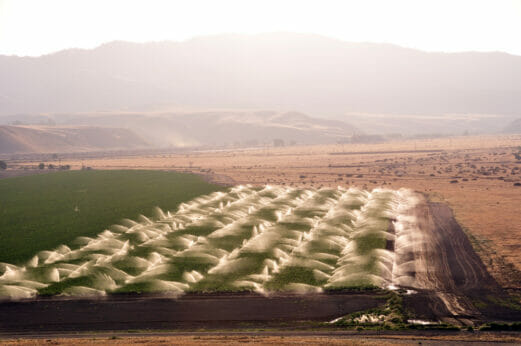
Irrigating fields in the San Joaquin Valley. (Photo: Shutterstock)
The latest report also accounts for new factors that have surfaced. Updated climate models, for instance, forecast less precipitation and increased crop water demands. And a recent state proposal to release larger stored volumes into the Sacramento-San Joaquin Delta—an environmental measure intended to boost flows to protect endangered fish species—is expected to further tax state reservoirs.
While the combined impacts could dry up as much as 20 percent of the valley’s agricultural water needs, increasing and optimizing supplies can go a long way in cushioning the blow.
One of the most affordable approaches—and seemingly obvious this past winter—is banking excess rain. “California still has cycles of wet years, when there’s a lot of water that we can’t capture in reservoirs,” says Escriva-Bou. And to minimize flood risk, the state keeps storage capacity partly empty during the winter in anticipation of storms. Rather than flushing those flows out into the Pacific, some of the volume can be banked underground.
Managed Aquifer Recharge (MAR) uses dedicated recharge basins in areas with sandy soil to percolate water into aquifers. “It’s one of the cheapest supply options,” says Escriva-Bou, “because in many cases, we already have the infrastructure.” Although large-scale efforts require building levees, flooding farmland during the wet off-season can be just as effective—“though you have to convince farmers that it’s not a problem for their crops or tree roots, as it’s not a traditional farming practice,” he says. And because the endeavor involves some outlay in labor and expense by growers for the benefit of the larger basin, it’ll take financial incentives to persuade the masses, he notes.
The most effective strategy to reduce impacts, however, is maximizing the available supply and working cooperatively within the vast, eight-county valley to leverage its wide range of conditions.
Individual basins can have large internal differences in water availability: Some areas receive no surface water and grow profitable crops such as fruits and nuts, while those in nearby irrigation districts may have more latitude to grow thirstier but less profitable crops such as alfalfa. In a triage of sorts, trading reallocates groundwater to locales where cutbacks would be most costly, to minimize economic impact.
And “because [you’re drawing from] the same aquifer, you don’t need additional infrastructure,” says Escriva-Bou. With agricultural wells now required to be metered, the process becomes a matter of accounting.
Along with intra-basin trading, implementing a valley-wide surface water exchange would magnify that flexibility, redirecting supplies from the region’s rainier, northern reaches to drier and highly overdrafted districts to the south and east. The report estimates that, together, the two trading scenarios could shrivel forecasted GDP losses by as much as half and job losses by up to 44 percent.
Yet without trading, overdrafted basins would face water cutbacks for all crops. Perennials, which cover 61 percent of the valley, would be hit especially hard, with orchard farms and vineyards left even more vulnerable. “There’s a huge difference between growing alfalfa and trees or vines, because [the latter] are 12- to 25-year investments,” says Tory Torosian, the fruit farmer. “If you’ve spent all that money to get an orchard in and suddenly there’s not enough water, you’re really up [a] creek.”
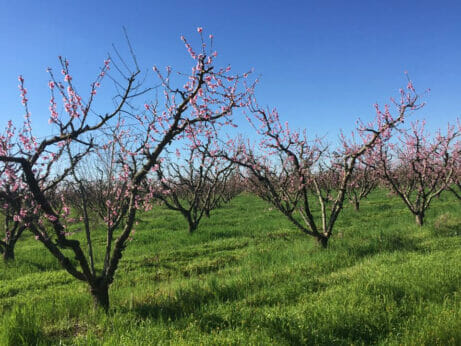
A view of Tory and Rebecca Torosian’s orchard. (Photo courtesy of Tory Farms)
The haves and the have-nots
Although water trading can be construed as commodifying a resource, “in this context, it’s a tool for reallocation,” says Escriva-Bou. Access to water divides the agricultural industry into the haves and the have-nots, he adds. “So without any trading, you’re condemning the have-nots to [further] socioeconomic losses.” In other words, trading can rebalance the supply to benefit entire basins and the valley as a whole.
While seemingly straightforward, the proposition requires navigating uncharted territory to develop new regulations. Although surface trading is an existing practice, strict measures and infrastructure limitations often relegate it to tightly prescribed boundaries, largely within a county or irrigation district. And currently, most places in California ban groundwater trading altogether, says Escriva-Bou, although a few districts have started to develop plans. It’s a complex endeavor that requires controls to prevent impacts, he adds. Too much pumping in a given location, for instance, can cause subsidence or tax shallower domestic wells.
Ultimately, small-scale farmers like Torosian hope for straightforward solutions that won’t require a dedicated compliance team. “I think all of us understand that SGMA is just common sense,” he says. “I just hope we’re not going to lose all the little guys in the process.”
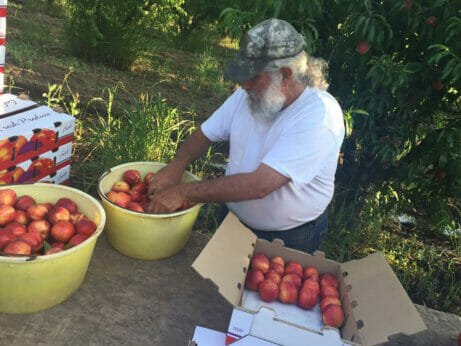
Tory Torosian packs nectarines. (Photo courtesy of Tory Farms)
Escriva-Bou emphasizes that SGMA’s goal is to equalize allocations for all growers. In the past, “it was easier for big farms to keep digging deeper wells,” he says. “SGMA puts a stop to these unsustainable practices and helps stabilize groundwater decline.”
“California agriculture will still thrive if we actually take the right steps and actions,” says Escriva-Bou. Innovation and flexibility are hallmarks of the trade, he adds, noting that the state has seen steady increases in yield for almost every crop for the past 40 years—a trend he expects to continue, even with less water and acreage.
“Ten years ago, nobody even wanted to talk about groundwater regulations,” says Escriva-Bou, “but now, we have an actual plan to face that reality. So, I’m optimistic.”
Not a mention of plastic!!!
CA also doesn’t have all the needed reservoirs. Money’s been voted to fund them but “environmentalists” keep throwing obstacles in the way. We lost a LOT of water from this past rainy season, just went into the ocean. Should never have happened.
Kind of difficult to write an article like this without using the word, “almonds”.
Experiences in Syntropic agriculture have shown that plants can ‘drink’ water directly from the humidity in the atmosphere, even in times of drought. Hydroscopic mycorrhizal fungi have the ability to condense and conduct moisture to the plant’s root zone, on demand, directly from humidity in the air. Even in deserts there is some percent of humidity in the air, especially at night. But only plants in the vigorous part of their growth curve have hydroscopic fungal partners, once the plant begins to mature or show signs of senecence it’ll change its fungal associate to a hydrophobic species, drying the soil… Read more »